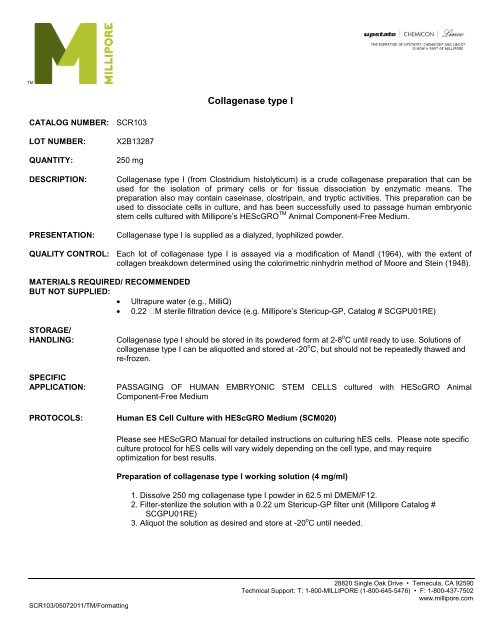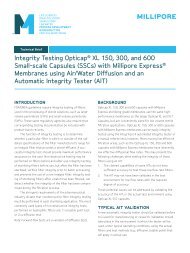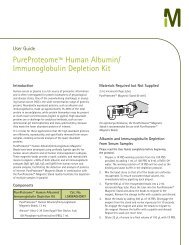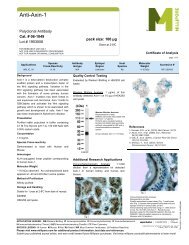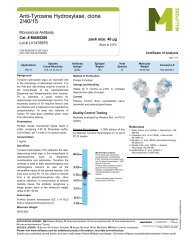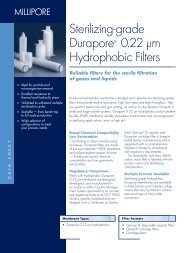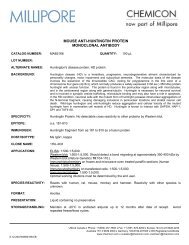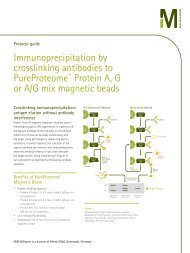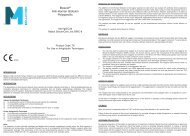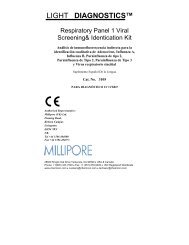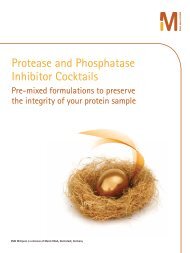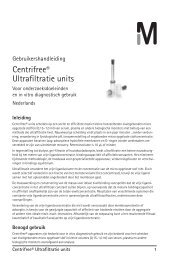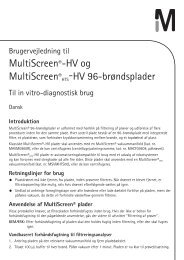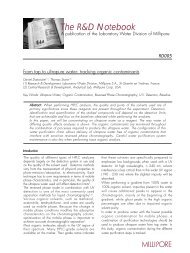Collagenase type I - Millipore
Collagenase type I - Millipore
Collagenase type I - Millipore
You also want an ePaper? Increase the reach of your titles
YUMPU automatically turns print PDFs into web optimized ePapers that Google loves.
CATALOG NUMBER: SCR103<br />
LOT NUMBER: X2B13287<br />
QUANTITY: 250 mg<br />
SCR103/05072011/TM/Formatting<br />
<strong>Collagenase</strong> <strong>type</strong> I<br />
DESCRIPTION: <strong>Collagenase</strong> <strong>type</strong> I (from Clostridium histolyticum) is a crude collagenase preparation that can be<br />
used for the isolation of primary cells or for tissue dissociation by enzymatic means. The<br />
preparation also may contain caseinase, clostripain, and tryptic activities. This preparation can be<br />
used to dissociate cells in culture, and has been successfully used to passage human embryonic<br />
stem cells cultured with <strong>Millipore</strong>’s HEScGRO TM Animal Component-Free Medium.<br />
PRESENTATION: <strong>Collagenase</strong> <strong>type</strong> I is supplied as a dialyzed, lyophilized powder.<br />
QUALITY CONTROL: Each lot of collagenase <strong>type</strong> I is assayed via a modification of Mandl (1964), with the extent of<br />
collagen breakdown determined using the colorimetric ninhydrin method of Moore and Stein (1948).<br />
MATERIALS REQUIRED/ RECOMMENDED<br />
BUT NOT SUPPLIED:<br />
• Ultrapure water (e.g., MilliQ)<br />
• 0.22 M sterile filtration device (e.g. <strong>Millipore</strong>’s Stericup-GP, Catalog # SCGPU01RE)<br />
STORAGE/<br />
HANDLING: <strong>Collagenase</strong> <strong>type</strong> I should be stored in its powdered form at 2-8 o C until ready to use. Solutions of<br />
collagenase <strong>type</strong> I can be aliquotted and stored at -20 o C, but should not be repeatedly thawed and<br />
re-frozen.<br />
SPECIFIC<br />
APPLICATION: PASSAGING OF HUMAN EMBRYONIC STEM CELLS cultured with HEScGRO Animal<br />
Component-Free Medium<br />
PROTOCOLS: Human ES Cell Culture with HEScGRO Medium (SCM020)<br />
Please see HEScGRO Manual for detailed instructions on culturing hES cells. Please note specific<br />
culture protocol for hES cells will vary widely depending on the cell <strong>type</strong>, and may require<br />
optimization for best results.<br />
Preparation of collagenase <strong>type</strong> I working solution (4 mg/ml)<br />
1. Dissolve 250 mg collagenase <strong>type</strong> I powder in 62.5 ml DMEM/F12.<br />
2. Filter-sterilize the solution with a 0.22 um Stericup-GP filter unit (<strong>Millipore</strong> Catalog #<br />
SCGPU01RE)<br />
3. Aliquot the solution as desired and store at -20 o C until needed.<br />
28820 Single Oak Drive • Temecula, CA 92590<br />
Technical Support: T: 1-800-MILLIPORE (1-800-645-5476) • F: 1-800-437-7502<br />
www.millipore.com
SCR103/05072011/TM/Formatting<br />
Passaging of human ES cells cultured in HEScGRO Medium<br />
1. To passage human ES cells using collagenase <strong>type</strong> I, remove the HEScGRO culture medium<br />
and overlay cells with approximately 0.05-0.1 ml/cm 2 of the collagenase <strong>type</strong> I working<br />
solution. Place culture vessel at 37 o C in a humidified cell culture incubator.<br />
2. After 10 minutes, check cells for signs of rounding up at the edges of colonies; if this is<br />
occurring, proceed to step 3. Otherwise place cells back at 37 o C for another 5 minutes (i.e.,<br />
15 minutes total) before proceeding.<br />
3. Remove cells from the culture surface by washing the surface with HEScGRO<br />
Medium(Catalog Code SCM020)* at a volume ratio of 3:1 (HEScGRO Medium:collagenase<br />
<strong>type</strong> I) with a serological pipet. Cells are removed by repeated washing with the same<br />
volume of HEScGRO Medium*; do not scrape cells off the culture surface, as this increases<br />
differentiation upon replating.<br />
Note that the human ES cell colonies will not dissociate to single cells when washed from the<br />
culture surface, but will remain in small pieces.<br />
4. Centrifuge cells at 75g for 5 minutes, wash the pellet with HEScGRO Medium* and centrifuge<br />
again.<br />
5. Resuspend the pellet with HEScGRO Medium and replate the human ES cells on a fresh<br />
feeder layer of Detroit 551 human fibroblasts at an appropriate split ratio (according to the<br />
density of the original culture; usually 1:3 to 1:6).<br />
*HEScGRO Basal Medium (SCM021) may be substituted for HEScGRO Medium in steps 3<br />
and 4<br />
REFERENCES Mandl, I., Keller, S. and Manahan, J. (1964). Biochem., 3: 1737.<br />
Moore, S. and Stein, W.H. (1948). J. Biol. Chem., 176: 367.<br />
Important Note: During shipment, small volumes of product will occasionally become entrapped in the seal of the product vial. For<br />
products with volumes of 200 μL or less, we recommend gently tapping the vial on a hard surface or briefly<br />
centrifuging the vial in a tabletop centrifuge to dislodge any liquid in the container’s cap.<br />
FOR RESEARCH USE ONLY; NOT FOR USE IN DIAGNOSTIC<br />
PROCEDURES. NOT FOR HUMAN OR ANIMAL CONSUMPTION<br />
Unless otherwise stated in our catalog or other company documentation accompanying the product(s), our products are intended for research use only<br />
and are not to be used for any other purpose, which includes but is not limited to, unauthorized commercial uses, in vitro diagnostic uses, ex vivo or in vivo<br />
therapeutic uses or any <strong>type</strong> of consumption or application to humans or animals.<br />
©2008 - 2011: <strong>Millipore</strong> Corporation. All rights reserved. No part of these works may be reproduced in any form without permission in writing.<br />
28820 Single Oak Drive • Temecula, CA 92590<br />
Technical Support: T: 1-800-MILLIPORE (1-800-645-5476) • F: 1-800-437-7502<br />
www.millipore.com


